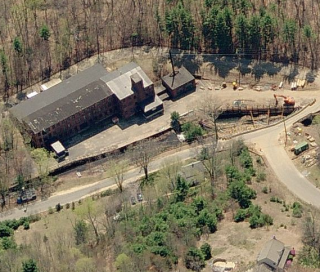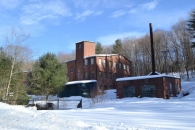Mill Record Stafford
RETURN TO ‘FIND MILLS’Disclaimer: Content for these properties was compiled in 2014-2017 from a variety of sources and is subject to change. Updates are occasionally made under Property Information, however the Connecticut Trust for Historic Preservation (dba Preservation Connecticut) makes no representation or warranty that the information is complete or up-to-date.
- Complex Name (Common)
- Rawitser & Brothers
- Complex Name (Historic)
-
- Rawitser & Brothers
- Address or Location
- 49 New City Road, Staffordville, Stafford
- County
- Tolland
- Historic Designation
- Associated Mill Community

- Historic Information
Companies Associated w/Complex
- American Felt Co. 1964-1988
- Drycor Felt Co. 1946-1964
- Fabyan Woolen Co. #1 1904-ca. 1929
- Rawitser & Brothers 1890-1904
Use (Historic)
Largest Documented Workforce
200 (ca. 1900)
Historic Narrative
One of the largest and most notable industrial firms in Stafford’s history was formed by three German immigrant brothers, Lewis, Adolph, and Herman Rawitser, shortly after the conclusion of the Civil War. Known as Rawitser and Brothers, the company initially produced cheviots for suiting and overcoats in a mill on what is now known as New City Road, this built and formerly occupied by the Home Manufacturing Company. In 1872, Rawitser and Brothers drastically expanded their operations by building an additional manufacturing plant, known as the River Mill, which was located between River Road and the Willimantic River, just south of the Stafford Springs central business district, as well as by purchasing a shoddy mill formerly operated by the firm of Ray and Company, which was located on the opposite side of the Willimantic River a short distance south of the River Mill. The expanded capabilities of Rawitser and Brothers allowed them to produce a broad line of medium-quality woolen goods, primarily dress clothing. Rawitser and Brothers made further investments in their Stafford operations in 1890 when they demolished the old Home Manufacturing Company mill and erected a new three-story red brick plant on the site. A history of Stafford from 1895 notes that the new factory was equipped with three carding machines and twenty-six broad looms, and supplemented not only the firm’s two local plants, but also two additional mills that by that time had been acquired in Meriden and Mystic, Connecticut. In 1904, the firm was reorganized as the Fabyan Woolen Company, with Herman and Simon Rawitser of New York, New York, and Charles H. Meghs, Jr. and Sidney Siswich of Stafford, serving as incorporators. Herman Rawitser held the position of company president, while Simon Rawitser functioned as both secretary and treasurer. The Fabyan Woolen Company employed over 200 workers in Stafford around the turn of the nineteenth century. In 1911, the main portion of the River Mill was destroyed by fire and although the company chose not to rebuild, the firm continued to operate its other two Stafford mills through the early decades of the twentieth century. Things came to a close, however, with the onset of the Great Depression, and the firm was dissolved in 1929. The shoddy mill (presently 32 River Road) was continued under the T.F. Mullen Company (later acquired by its present tenant, the 3M Company), while former storage buildings built for the Fabyan Woolen Company (presently 14 River Road) were acquired by the Consolidated Warp Company before passing to the Connecticut Light and Power Company in the 1940s. The Fabyan Woolen Company’s mill on New City Road stood vacant for several years before it was eventually purchased by the Drycor Felt Company in 1946. Drycor Felt was organized in Belleville, New Jersey, in 1935, and the company manufactured felt products used in industrial processes in leased space for the first decade of its existence. Drycor erected two substantial red brick additions to the New City Road plant upon acquiring the building, these located on its southern and western elevations. The company occupied the factory in 1948 and was still in operation there in 1960 when it was absorbed by the American Felt Company. Production under the American Felt Company included the manufacture of goods associated with its Industrial, Floor Products, and Building Products Divisions, and continued until 1988 when the plant was closed as part of a corporate consolidation. The mill is currently vacant.
- Architectural Information
Number of Existing Buildings
Six (6) primary blocks.
Dates of Construction
1890, ca. 1920, ca. 1946, Mid-to-late-20th c.
Architect
n/a
Builder
n/a
Building Type
Architectural Description
The former Rawitser and Brothers plant is comprised of five adjoining blocks and a freestanding powerhouse located on the south side of New City Road opposite Virginia Drive. The core of the plant consists of a three-story, 126’ x 40’ red brick manufacturing building with segmental-arched window openings, stone windows sills, double-hung twelve-over-twelve frame sash, plain wood cornice, and a low-pitch side-gabled roof. Early photographs of the building indicate that the block was originally erected in 1890 as a 13-bay structure, with the three bays at the eastern end of the mill erected ca. 1920. The central of the three later bays has a hoist beam at the roofline, and wide segmental-arched openings that originally housed a pair of loading doors on the second and third floors. The doors remain on the second floor but have been replaced with a pair of double-hung windows on the uppermost level. One-story red brick ancillary blocks were originally located at the western end of the main block, however, these were replaced with a three-story, 54’ x 55’ red brick block ca. 1946. The southern two-thirds of the block aligns with the gable roof of the main block, while the remainder of the addition extends to the north under a shed roof. The building has rectangular window openings with concrete sills and multi-pane metal sash with hopper style openings. A four-story red brick stair tower rises from the center of its north elevation. Further additions to the plant completed ca. 1946 include a one-story, 148’ x 40’ red brick block with a low-pitch shed roof adjoining the southern elevation of the main block, and a one-story, 36’ x 30’ red brick boiler house with flat roof and steel smokestack standing roughly 24’ west of the mill. These two structures are similar in styling to the other ca. 1946 addition. Two further additions to the plant took place at unknown dates during the second half of the 20th century. They are a pair of one-story, wood-frame shipping and storage buildings located at the east and west ends of the plant’s north elevation. They have concrete foundations, metal siding, garage-style doors, and shed roofs.
Exterior Material(s)
Structural System(s)
Roof Form
Roof Material
Power Source
Condition
Fair
Condition Notes
The factory is in overall fair condition. The majority of the exterior walls appear to be well maintained, however, show some signs of staining and deterioration, as do the various roofs. The original wood windows found in the original block show signs of deterioration and many missing panes. The steel sash found in the ca. 1946 blocks is in fair shape overall.
- Property Information
-
Specific Location
One 4.2-acre parcel (49 New City Road) on the south side of New City Road opposite Virginia Drive.
Adjacent To
Exterior Visible from Public Road?
Yes
Parcel ID / Assessor Record Link
- 30/ / 41 / Link →
Acreage
4.2
Use (Present)
- Sources
-
Form Completed By
Lucas A. Karmazinas
Date
02/24/2015
Bibliography
- Map of Tolland County, Wm. C. Eaton & H.C. Osborn, 1857.
- Atlas of Tolland County, O.W. Gray, 1869.
- Sanborn Map Company, 1884, 1892, 1897, 1911, 1921, 1930, 1943.
- Aerial Survey of Connecticut, 1934, 1965.
- Birdseye View of Stafford Springs, Conn., O.H. Bailey & Co., 1878.
- List of Connecticut Manufacturers, 1922, 1924, 1930, 1932.
- Directory of Connecticut State Manufacturers, 1936, 1939.
- Industrial Directory of Connecticut, 1947.
- Register of War Production Facilities in Connecticut, 1951.
- Hartford Courant, 1904, 1988.
- History of the Town of Stafford, Stafford Library Assoc., 1935.
- Stafford, Connecticut, 250th Anniversary, 1969.
- Stafford Illustrated, Young, William, 1895.
- Town of Stafford HRI, Gibbs, James, 1993.
- Representative View(s)Click on image to view full file







